Margarine Myths – Turkeys, Plastic, & More
This post may contain affiliate links. Read my full disclosure here.
Misinformation never dies on the internet – it just gets turned into another Facebook meme that gets shared over a million times. Today’s case in point – margarine myths. I am not a fan of margarine. I think it’s a sad excuse for butter, and always has been. That said, the whackadoo information and fearmongering being shared on the internet is just plain silly. If you’re going to avoid bad food, do it for legitimate reasons. There are plenty of them.
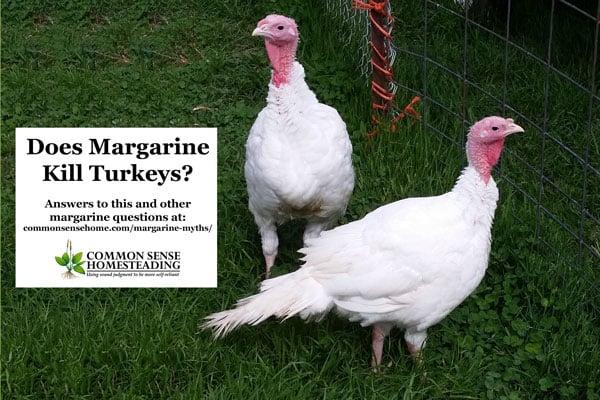
In this post I’ll present some margarine myths and the real problems with margarine.
Margarine Myth #1 – Margarine Kills Turkeys
Here’s the internet margarine myth:
Margarine was originally manufactured to fatten turkeys. When it killed the turkeys, the people who had put all the money into the research wanted a payback so they put their heads together to figure out what to do with this product to get their money back.
THIS IS FALSE – Margarine was invented in France by Hippolyte Mege-Mouriez as a cheap butter alternative to feed Emperor Napoleon III’s troops back in 1869. The original formula was based on beef tallow and milk in combination with margaric acid, and was called oleo-margarine. Current margarine products are made with vegetable oil blends.
To the best of my knowledge, no turkeys have been directly killed by margarine, however, consuming large amounts of margarine may reduce turkey lifespans and overall health. (See transfat concerns below.) Alternatively, if a case of margarine landed on a turkey, that might lead to the turkey’s demise.
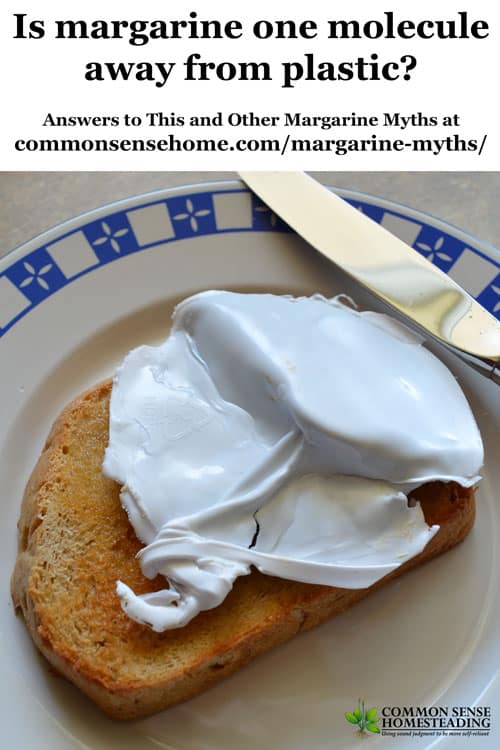
Margarine Myth #2 – Margarine is but ONE MOLECULE away from being PLASTIC… and shares 27 ingredients with PAINT
Here’s the internet margarine myth:
Margarine is but ONE MOLECULE away from being PLASTIC… and shares 27 ingredients with PAINT.
These facts alone were enough to have me avoiding margarine for life and anything else that is hydrogenated (this means hydrogen is added, changing the molecular structure of the substance).
Open a tub of margarine and leave it open in your garage or shaded area. Within a couple of days you will notice a couple of things:
* no flies, not even those pesky fruit flies will go near it (that should tell you something)
* it does not rot or smell differently because it has no nutritional value ; nothing will grow on it. Even those teeny weeny microorganisms will not a find a home to grow.
Why? Because it is nearly plastic . Would you melt your Tupperware and spread that on your toast?
FALSE – well, not just false, more like completely nonsensical. It’s like saying apples are one fruit away from an orange because they both grow on trees.
As for the paint comment, which margarine and which paint? Ingredients can be used for more than one purpose. I may mix up a batch of weed killer out of concentrated vinegar that gets rid of weeds in the sidewalk cracks, but that doesn’t mean I can’t use the same vinegar to make a batch of pickles.
What’s the Difference Between Butter and Margarine?
Both margarine and plastic contain hydrocarbons. Hydrocarbons are organic compounds that are made of only hydrogen and carbon atoms. Common hydrocarbons include oil and gas. That doesn’t mean that foods with hydrogen and carbon atoms are dangerous.
It’s all about how the atoms within the molecule are arranged. You wouldn’t guzzle down a jug of hydrogen peroxide (H2O2), but water (H2O) makes a refreshing beverage.
Butter is a saturated fat. This means all its carbon bonds are filled, mostly with hydrogen. While previously villainized as evil, saturated fats have been cleared of wrong doing and are essential to good health.
Margarine is made out of poly-unsaturated fats, which means that some of the carbon atoms are initially double bonded. To make these vegetable oils thick and spreadable (like butter), they use some processed food chemical magic to add more hydrogen. This is called hydrogenation. Unless you’ve been living under a rock, you’ve probably heard that hydrogenated oils (also known as transfats) are not good for you.
The video below gives a good explanation of the chemistry of butter and margarine in easy to understand terms. I don’t agree with their push for veggie oil at the end, since many vegetable oils are now genetically modified and/or heavily processed, but it takes a while for the mainstream to accept new info. Personally, I recommend good quality fats (pastured animal products when you can get them and responsibly raised coconut and palm oils and olive oil) as part of a healthy diet. If I can’t get grassfed (or it isn’t in the budget), I go for the least processed option available.
As for the part about the flies and fruit flies won’t eat margarine…
Fruit flies are attracted to fruit, not oil. Of course they don’t bother margarine. I haven’t tested margarine, but a while back we did a little homeschooling test with non-dairy whipped topping and real raw whipped cream. They both sat in my north window from March to October, virtually unchanged. The raw cream did attract one bug, the whipped topping attracted none.
Although I didn’t taste them, I’m 99% sure the raw cream simply soured over time, which stabilized it. (Not tasty, but functional.) The whipped topping weeped out some clear liquid (likely water, because it evaporated over time) and shrunk up like a shrinky-dink toy. When I poked both products before dumping them into the compost, the cream had formed a protective crust with uniform white filling, and the whipped topping had a uniform foam texture.
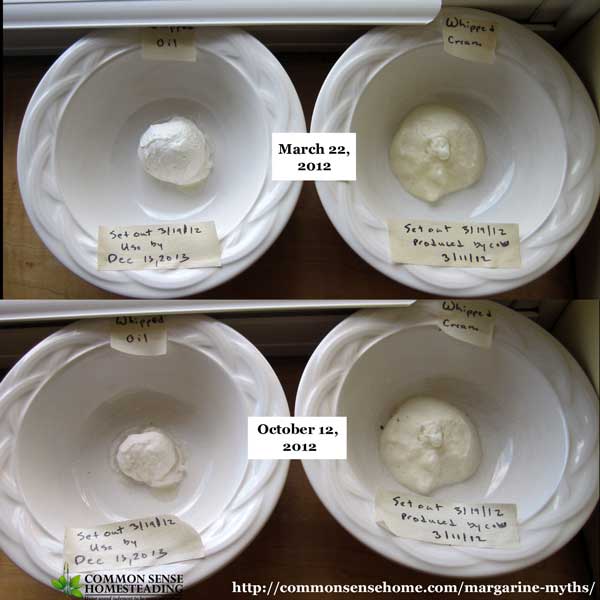
For good measure, we also lit some whipped topping and whipped cream on fire with the kitchen torch. The whipped cream melted, the whipped topping scorched.
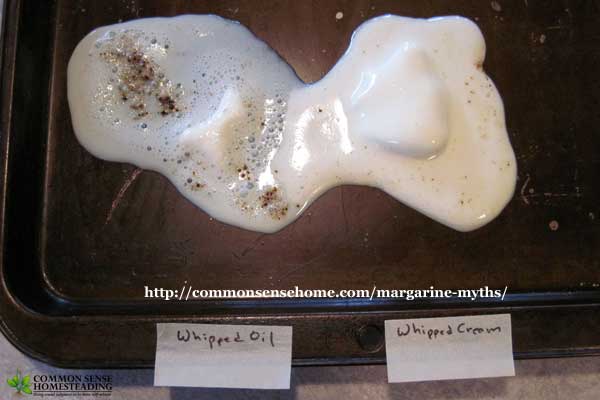
Margarine Meme Information that is True
Meme info in bold italics, comments in regular text.
Margarine is Colored
Margarine was a white substance with no food appeal so they added the yellow coloring and sold it to people to use in place of butter.
The original margarine was white (after all, it was mostly beef tallow), which did lack table appeal and so color was indeed added. Margarine was fought by dairy interests, and selling margarine was outlawed in some states – although others required that margarine be dyed pink to make sure it wasn’t passed off as butter. Some people took to mixing colors into their margarine at home (white margarine was conveniently sold with a yellow dye packet). See Margarine: An Economic, Social and Scientific History, 1869-1969.
Margarine and Butter Have a Similar Amount of Calories, Margarine May Have Less Saturated Fat
Margarine and Butter Have the Same Amount of Calories
Regular and butter and margarine are both fats, and have about 100 calories per tablespoon. Funky whipped products may have less calories (and less product) in a spoonful.
Butter is slightly higher in saturated fats at 8 grams; compared to 5 grams for margarine.
See above video and comments. Butter is a saturated hydrocarbon.
Margarine is Linked to Increased Disease and an Increase in All Cause Mortality
Eating margarine can increase heart disease in women by 53% over eating the same amount of butter, according to a recent Harvard Medical Study.
This mystery study is nowhere to be found, but the article Trans fats, but not saturated fats, linked to greater risk of death and heart disease states of another recent study:
“The team found no clear association between higher intake of saturated fats and all cause mortality, coronary heart disease (CHD), cardiovascular disease (CVD), ischemic stroke or type 2 diabetes, but could not, with confidence, rule out increased risk for CHD death. They did not find evidence that diets higher in saturated fat reduce cardiovascular risk.
However, consumption of industrial trans fats was associated with a 34% increase in all cause mortality, a 28% increased risk of CHD mortality, and a 21% increase in the risk of CHD.”
Link to the featured study, by Dr. Russell J de Souza, et al:
Would you like to save this?
Related transfat research studies by Dr. DiNicolantonio:
Margarine triples risk of coronary heart disease …
Per the study by Dr. Russell J de Souza, et al, 28% increased risk of death from coronary heart disease (CHD).
Margarine is Linked to Cancer
Margarine increases the risk of cancers up to five times..
From Margarine significantly increases your risk of developing Breast Cancer:
In 1996, Swedish researchers decided it was time for a human study to provide some hard data on breast cancer. Scientists from the Karolinska Institute recruited 63,870 women aged 40–76 and monitored their diet and the occurrence of breast cancer for an average of 4.2 years. The dietary questionnaires used in the study enabled the researchers to determine exactly how much saturated, monounsaturated and polyunsaturated fat the women were consuming.
They found no association between the total fat or saturated-fat (the dominant fat in animal fats) intake and a woman’s risk of developing breast cancer. Monounsaturated-fat (the dominant fat in Olive Oil) consumption reduced the risk of breast cancer by 20 per cent but polyunsaturated-fat consumption did exactly the opposite. Just as the rat studies had predicted, the women consuming the most polyunsaturated fat were 20 per cent more likely to develop breast cancer than the women consuming the least.
Margarine may be High in Trans Fatty Acids, Increase Cholesterol and Lower Breast Milk Quality
Margarine is very high in trans fatty acids.
It depends on the margarine, as explained in the video. Hard (stick) margarine tends to have more transfats, soft spreads generally have less.
Margarine increases total cholesterol and LDL (this is the bad cholesterol) and lowers HDL cholesterol, (the good cholesterol)
Again, it depends on the margarine, but yes, this is likely. That said, cholesterol is only one factor in health health and overall health. See “15 Home Remedies to Naturally Reduce Cholesterol and the Risk of Heart Attack” for more information.
Margarine lowers quality of breast milk
This gets back to the fatty acid balance. Margarine has omega 6 fatty acids. Most of us consume too many omega 6 fatty acids and not enough omega 3 fatty acids. If you don’t have omega 3s in your diets, you won’t have them in adequate quantities in your breast milk.
Margarine may affect the Immune System and Blood Sugar Regulation
Margarine decreases immune response and decreases insulin response.
Some adverse effects of consuming trans fatty acids reported in humans and animals include the following:
- increases blood insulin levels in humans in response to glucose load, increasing risk for diabetes;
- interfere with the ability of new mothers to nurse successfully and increase the likelihood of developing diabetes (lowers the amount of cream by volume in milk from lactating females in all species studied, including humans, thus lowering the overall quality available to an infant);
- predispose pregnant mothers to low-birth-weight babies;
- causes a dose response decrease in visual acuity in infants who are fed human milk with increasing levels of trans fatty acids, which extends to 14 months of age;
- affects immune response by lowering efficiency of B cell response and increasing proliferation of T cells;
- decreases the response of the red blood cell to insulin, thus having a potentially undesirable effect on diabetes;
- causes alterations in adipose cell size, cell number, lipid class, and fatty acid composition;
- contributes to osteoporosis;
- decreases testosterone, causes the production of abnormal sperm and altered gestation;
- causes adverse alterations in the activities of the important enzyme system that metabolizes chemical carcinogens and drugs;
- precipitates childhood asthma;
- interferes with the body’s use of omega-3 fatty acids found in fish oils, grains and green vegetables, leading to impaired prostaglandin production;
- increases the incidence of heart disease because trans fatty acids lower HDL cholesterol, increase LDL and increase the heart disease marker Lipoprotein [a] (Lp[a]) while saturated fats lower Lp[a};
- raises total serum cholesterol levels 20-30mg%; and
- causes adverse alterations in physiological properties of biological membranes including measurements of membrane transport and membrane fluidity.
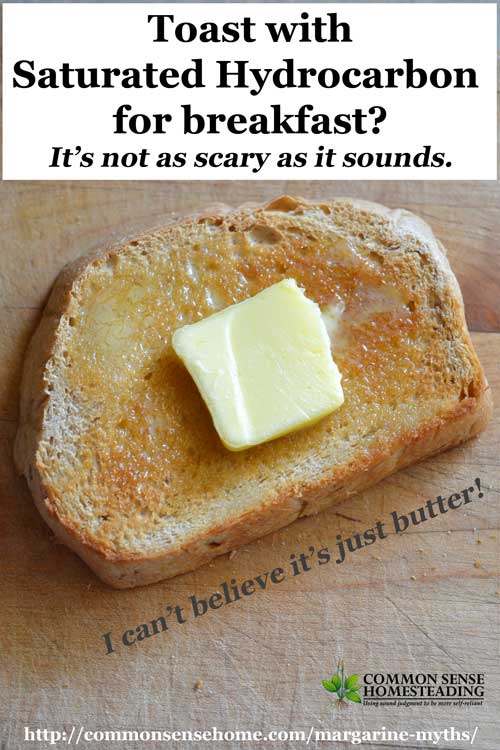
Butter Helps you to Absorb Nutrients and is More Nutritious
Eating butter increases the absorption of many other nutrients in other foods.
True – fat soluble vitamins such as A, D, E and K require fat to be properly absorbed and used by the body. Caveat – other quality fats will work just as well.
Butter has many nutritional benefits where margarine has a few and only because they are added!
It depends on the butter and the margarine. Grass fed butters tend to have nice bright color and higher levels of essential fatty acids, vitamins A, E and Beta-carotene.
Butter tastes much better than margarine and it can enhance the flavors of other foods.
Purely subjective, but I much prefer butter.
Butter has been around for centuries where margarine has been around for less than 100 years .
Margarine was created in 1869, so it’s been around for over 100 years, but I still trust cows more than chemists.
As you can see, the transfats in margarine and other processed foods are not a health food, even without dead turkeys and plastic being involved. Let’s stick to just the facts instead of spreading misinformation!
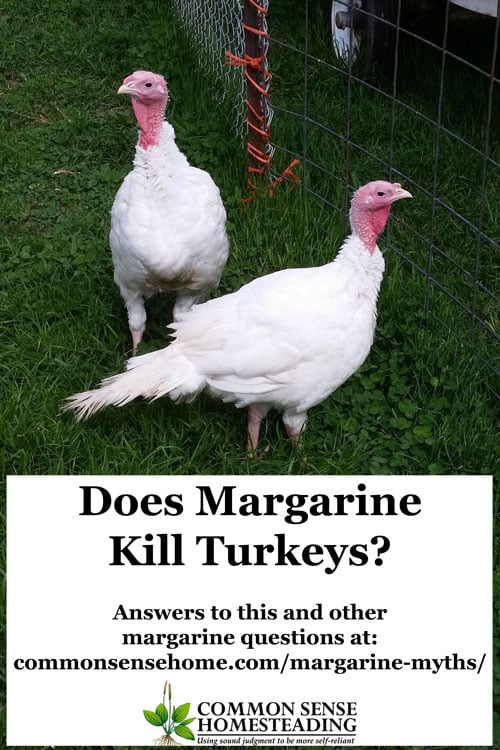
Recommended Resources
- Eat Fat, Get Thin: Why the Fat We Eat Is the Key to Sustained Weight Loss and Vibrant Health
- The Big Fat Surprise: Why Butter, Meat and Cheese Belong in a Healthy Diet
- Smart Fat: Eat More Fat. Lose More Weight. Get Healthy Now.
This post is part of the “Common Sense Isn’t So Common” series addressing misinformation on the internet.
Other posts in the series include:
- Stop the Dandelion Madness!
- The Ugly Truth About PETA
- The First Supermarket Appeared in 1946, Before That, Food Was All Local
Have you seen information on the internet related to health, gardening or other topics covered on the site that’s just plain wrong? Leave a comment and let me know.
Last updated in 2017.

A nice well-researched article Laurie – thanks so much for sharing.
It’s my understanding that a “molecule” is the smallest bit of something that still retains all the characteristics of the whole. So in that way, you can’t have a molecule of an apple unless it has everything the whole apple has (skin, seeds, core, flesh….) and you can’t have a molecule of a person that would be smaller than the actual person. That means that I am a molecule of me – made up of zillions of atoms for sure, but no PART of me can be a “molecule of me” – only the whole. So yes, margarine is only one molecule away from plastic, but also only one molecule away from an apple, or a person. Whoever started the whole “one molecule away from plastic” thing was using “molecule” as a misnomer. He/she may have meant to say “only one chemical atom bond away from plastic”, which is still wrong regardless of type of plastic.
Food for thought, if you look at the atomic structure of hemoglobin from human blood, you might see that the complex molecule is exactly the same as the atomic structure of liquid chlorophyll (plant) except for one atom: the blood molecule has an atom of iron whereas the chlorophyll molecule has an atom of magnesium. Hemoglobin is only one atom different from (“away from”?)chlorophyll (Manfred urs Koch, the Whole Health Handbook, 1981;1984).
Anyway, margarine is gross and butter is pure Heaven.
Quite educative
Good Content. Check out this other page I found on how margarine is actually made. It finally convinced my Mother-in-law to start buying the good stuff.
http://heritageihc.com/blog/how-margarine-is-made/
I loved your article :). It was very informative and you hit all the right notes. I feel a little better about what I have in my fridge and not about to burn the tub of margarine because of what people share on social media. I am from California, Bakersfield. Those California Cows are us lol so I grew up eating Alta Dena butter and milks all fresh and moved to Arizona were I have admitted to buying margarine because butter is more expensive out here for some reason. But I am glad I know the REAL risks and not the myths. Thank you for putting me at ease, although I will like to make that sacrifice money wise and purchase real butter again because of the better qualities.
You’re welcome, Jennifer.
Dear Laurie,
Love the article on margarine. My family grew up on the stuff, but I never could stand it. Thank you for your “straight talk”. It helps to know the truth (as far as we know at the moment) with the fiction. I appreciate your hard work on keeping us informed.
PS is your psoriasis doing better?
(hope so)
Glad you approve, Elaine. My skin is HUGELY better. Thank you for caring. 🙂 The only areas that are left are some rough patches on the elbows (but still much better than they were), a tiny bit of redness under the breasts, and an itty bitty flaky spot on my right ear. I’ve been thinking I should update photos, but have been super busy with planting.
DEAR LAURIE,
LOVED YOUR ARTICLE ON JERUSALEM ARTICHOKES. HOWEVER, YOU MUST BE A CITY GIRL, WITH A GREEN THUMB. THAT’S GOOD.
I AM A FARMER, AND HAVE NEVER FOUND A “RUNAWAY” PLANT THAT COULD NOT BE CONTAINED.
HOWEVER, YOU ARE RIGHT, THE DAMNED THINGS ARE TERRIBLE COOKED. YOU HAVE TO BE VERY HUNGRY, OR WEIRD TO EAT THEM COOKED. BUT, ——AS “ARMENIAN PICKLES”, WITH CARROTS, CELERY,
CAULIFLOWER, AND CABBAGE, —-THEY ARE CRUNCHY MARVELS.
THEY DO REQUIRE SOAKING IN COLD WATER, AND SCRUBBING WITH A BRISTLE BRUSH, TO CLEAN OFF THE DIRT. BUT FOR MONTHS OF COLD WEATHER CRUNCHING AND MUNCHING, WITH ZERO CALORIES, THEY CAN’T BE BEAT.
RESPECTFULLY,
MICHAEL A. KOLIGIAN, D.V.M.
No sir, I was born and raised on a dairy farm in northwest Wisconsin, but right now we don’t have any critters, and no one else likes to eat the things except me. And my belly isn’t that big. 🙂